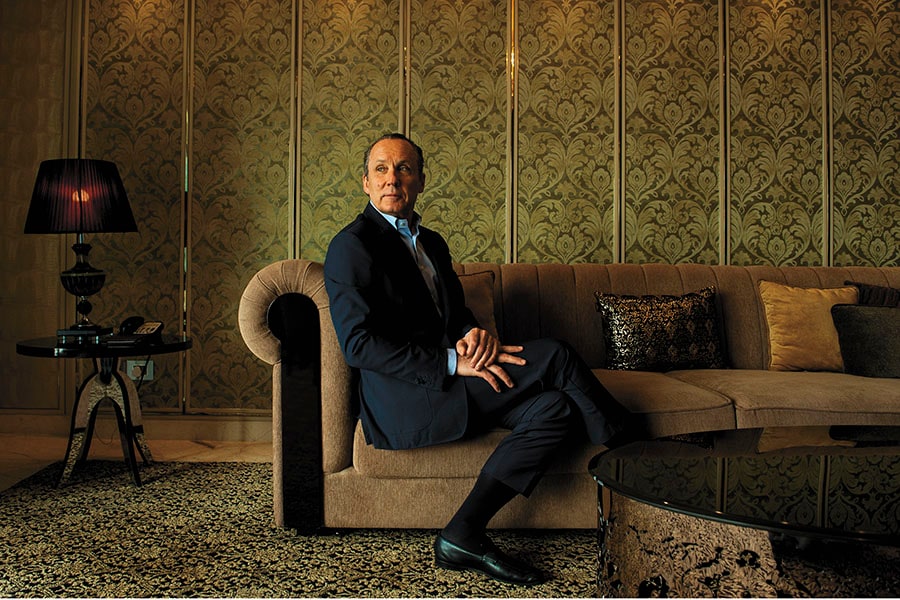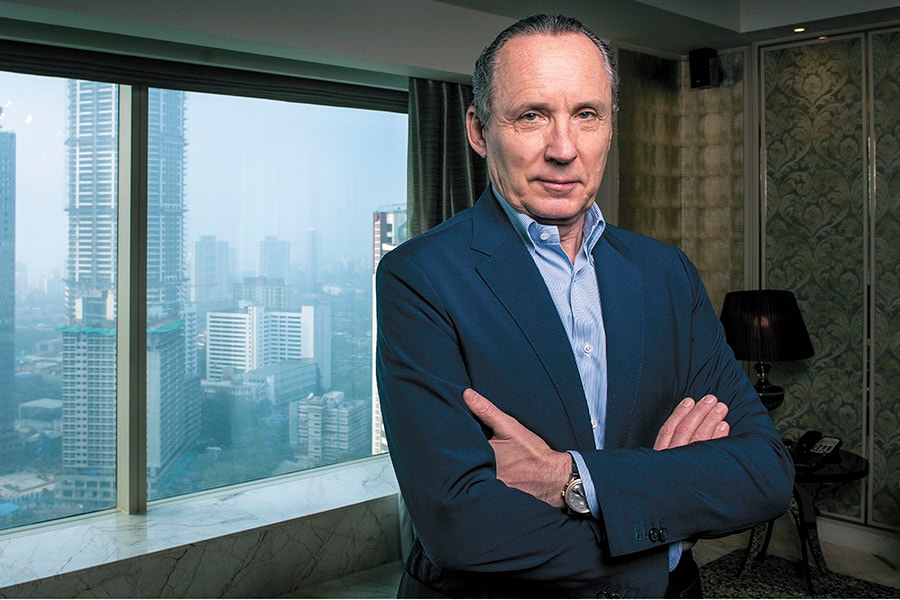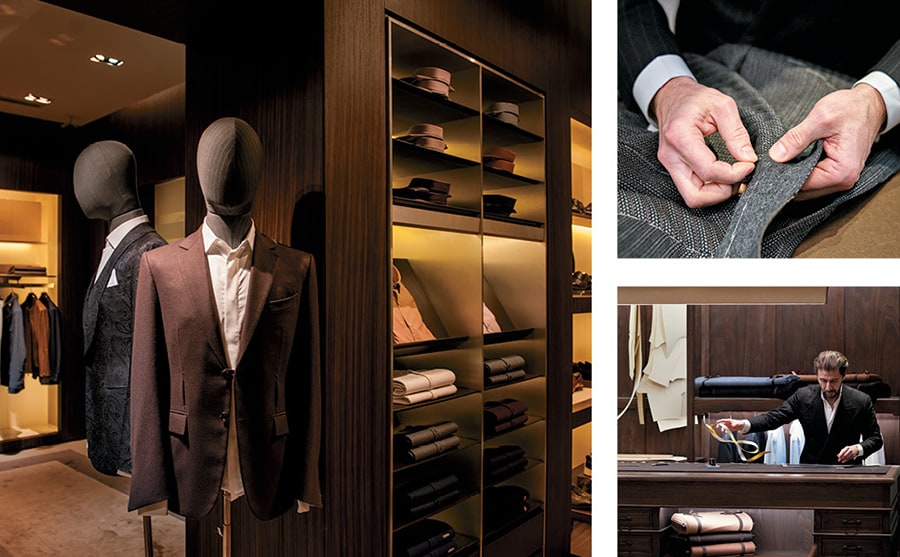
I see a different confidence in luxury: Ermenegildo Zegna
Zegna CEO Ermenegildo Zegna on the Indian market, personalisation in the age of casualisation, and balancing luxury and digital
 Ermenegildo Zegna, CEO, Ermenegildo Zegna Group, is constantly trying to bring something new to the party of dressing
Ermenegildo Zegna, CEO, Ermenegildo Zegna Group, is constantly trying to bring something new to the party of dressing
Image: Vikas Khot
Luxury brand Ermenegildo Zegna, which began as a small woolen mill in Trivero, Italy, in 1910, is today probably the biggest luxury menswear brand with 500-odd stores across the world. After a year of falling sales in 2016, the company has been getting back to growth. In 1991, it became the first luxury goods company to expand into China and, 10 years ago, it entered the Indian market, long before other luxury brands. CEO Ermenegildo Zegna, 62—grandson of the original Ermenegildo—who was in the country recently, spoke to Forbes India about how the brand has been transforming itself in the age of digital and of millennials, how the lessons he learnt when he worked in retail at Bloomingdale’s in New York in the ’70s still hold true and how they are in for the long haul in India. Edited excerpts from the conversation:
Q. How did Zegna succeed in arresting 2016’s trend of falling sales? What are the recent changes at the company?
I think we were known as a clothing company; today we are called a lifestyle brand where, with a change of lifestyle, men’s fashion is becoming more casual, more accessories driven, more digital. All these important features have to be met by any brand, including ours. So I’ve been working in the last couple of years to make it happen, and to turn back to growth.
We recently changed our artistic director (and brought in Alessandro Sartori). I think with him I brought a kind of rejuvenation, which goes exactly in this direction of casualisation, which can be intriguing, also for a millennial. There is a lot of talk about millennials, there are some luxury brands that have declared that 50 percent of business will be [accounted for by] millennials, which is huge, not necessarily in our case, but we cannot disregard this phenomenon.
One of our biggest markets is China and I think the Chinese and millennials, and digital, are three important ingredients that have to be taken seriously and our new brand strategy looks in that direction as well. And you have to cater to your loyal customer, because a few percentage points of clients make a big chunk of our turnover, so you have to keep those loyal customers happy.
Travel today is becoming an extremely important part of the equation so you have to create a travel wardrobe—items that are good for travel at the same time keeping the high quality associated with our brand. On the other side, you also need to do more fashion items. Sartori has created this collection, part of our couture collection, which is millennial, celebrity-driven, which is more than casual wear… very, very stylish. So the challenge is how to manage all these things together and still keep the DNA of the brand the same, which is made of 107 years of history.
Q. What, according to you, is the DNA of the brand?
The DNA is, surely, high-quality products with strong ingredients of innovation in what it represents in terms of performance, in terms of style, and a capacity to put the pieces together. You can tell a Zegna wardrobe by the look, and that is what Italian style is about. And we go from sheep to shop and shop to screen, in which we control the entire process from industry to product to store management and to the online future that we’ve brought around the world.
 Ermenegildo Zegna plans to have an important presence in Mumbai
Ermenegildo Zegna plans to have an important presence in MumbaiImage: Vikas Khot
Q. Fabric has been at the heart of Zegna. What’s the latest innovation from the house of Zegna?
Today I’m wearing a suit that is called Wash and Go. It is something you can put in the washing machine and pull it out and walk. And for somebody who travels, it’s washable, it could be worn with ties, as a blazer, it’s practical, good to travel, good to handle, lightweight for the climate, it doesn’t wrinkle… so it has all these peculiarities. We’ve been working on this product a while and I think we can bring something new to the party of dressing and of being comfortable in what you wear and feel at ease and yet luxurious.
Q. You’ve completed ten years in India. How has the journey been?
In India, we have three stores; hopefully we will add a couple in the next two years and in this new project that Reliance Industries is putting together at the Bandra-Kurla Complex (in Mumbai) we will have a strong presence with a global store. We were limited, in a way, in distribution and by the fact that it’s hard to figure where to open a store in India. The hotels have a limited traffic and malls are few, street level is almost impossible, so I think it’s a great project that they are putting together.
India is smaller as compared to other markets, but I see a different confidence in luxury. And as the distribution is developing, we have a much better chance to do well here.
Q. What is the percentage of the market of India vis-à-vis the rest of the world?
The number is so small that it’s not even worth mentioning. But we see a long-term equation. We don’t have to be impatient for India. We believe we will be here for many years, so we are patient. But in made to measure in percentage terms, India would be among the top Zegna markets. The made to measure business has been very significant in India and over the years, we have steadily built a loyal customer base.
Q. What are the specific initiatives for the Indian consumer?
We did some fabrics in silks for India, some accessories, the well-known Guru jacket with a special shape, for evening wear... these are some of the peculiar products we did. And more will come as we get to know the customer better. India loves colours, and embroidery from their artisanal capabilities, so as we get more spread out, we will surely do more exclusive products for this country.

Q. You said there are three things you are looking at: China, digital and the millennials...
If you are not serving China, you are in trouble. That’s true of any brand, whether you are talking about automotive, design, food. It’s just a huge market, they love newness, they love travel. And they change flow. One day they are here, the other day they are there, so you have to be truly smart to understand those flows and to anticipate. And they are becoming more and more service-oriented, so you have to be equipped. In several stores, we have Chinese-speaking staff that knows what he or she wants. We created this Techmerino project, which is the elder brother of Wash and Go. Techmerino is active performance wool, a product that is very casual, so we are bringing in this casualisation to a formal product and they (the Chinese)clearly jumped at that; it’s become one of the biggest things out there.
The other thing is personalisation. We do very well with made to measure, which incidentally makes up a big part of the Indian market too. We’ve created this unique service of bespoke tailoring in Milan and bespoke shoes in London. We created an atelier on the top of our Milan shop and this is with a private entrance, very exclusive service, and he (the tailor) travels the world to do this special suiting. And every suit is three trials with a very vast array of fabrics and very specialised in terms of the detail you want to add.
Q. How do you balance luxury and your in-store experience and bespoke services with digital?
I think they go hand in hand, because the way we see digital is slightly different than many others. Many have started by creating a virtual catalogue, which is going to be another means to increase sales. Or they want their virtual store to be the biggest store of the chain. We’ve started differently. We said we’d like to have digital and have the service level we provide in the store. So, through digital, you can book an appointment in your store, have your garment transferred from one store to another, or buy in the store and have it delivered to wherever you are, or check stock availability. It gives the customer more choices.
Deciding what’s online and offline is difficult, but I think one helps the other. And digital is also much more informative. Digital forces you to put interesting information in writing, in an emotional way… we’ve tried to really revolutionise our site by telling stories, by adding some humour, taking away some of the rigidity that digital can offer you, and create a new communication with the client.
This dialogue on digital is like a store window, it’s becoming the new window of the brand, I think this is the best way to put it.
Content is becoming an asset to be used in digital, storytelling is the new way to go. By telling the new brand story. And I think the millennial is more interested than anybody else in these things. I’m sure there are lots of 20/30-year-olds that have plenty of money, so the issue is not the economics, the issue is making them interested and making your brand relevant to them.
Q. You worked at Bloomingdale’s in America in the ’70s and then you have been with Zegna for 35 years. What are the lessons you picked up in the early days that are still relevant?
I started at Zegna in 1982. I was in Seattle exactly five days ago, to visit one of my original customers and we were commenting on the things that are still relevant. He said much of what you learnt from here still applies today. Many of the relevant aspects of merchandising I learnt in my early days are still true today, but it has to be communicated in a different way.
The customer experience, the relationship with the customer, it’s important even today but supported by new gadgets or means or tools. I think the people content is important and digital supports the people. And the customer still appreciates very much the personal relationship with the brand and you just have to give the option. It’s like a self-driving car: I don’t believe there would be either/or, yes, there would be self-driving cars, but if you wanted to drive your Alfa to the mountains with a manual gear, you can do so… give the customer the option of a self-driving car and doing your own manual crazy driving. So it’s creating the option.
Q. Which are the other exciting–and challenging–markets, apart from China?
I find Italy very exciting because we’re looking for a new business paradigm, we are trying to entertain our customers in a different way. Italy is the country where we were born, in which we have a very solid image, so the challenge is to make people understand how Zegna has changed. It’s easier to do it with the Chinese than Italians (laughs) because if you ask a taxi driver in Italy you know Zegna, he says of course I do. What does Zegna do, and he will say fabric, which is good but we have to make him understand that Zegna also does, say, beautiful shoes. It’s not easy to do so.
America is another challenge, a market I am excited about… it’s another market in which we are turning the perception of Zegna as a clothing brand into Zegna as a lifestyle brand. Russia, Japan, every country I have been to recently has been fun because it represents challenges.
The challenge in every market is to fine-tune the situation, and timing is important. Many times we made mistakes, we went in too quickly or we went in boom—five stores, ten stores. Do it more gradually, test it and then go more step by step and if something doesn’t work, just pull back and try a different way.
Q. How have the recent policy changes in India affected the brand?
These are small bumps on the road. It’s important to have both an investment appetite and a risk appetite in this business, which means you don’t measure the market in small phases. We call them bumps along the way.
(This story appears in the 30 November, -0001 issue of Forbes India. To visit our Archives, click here.)




